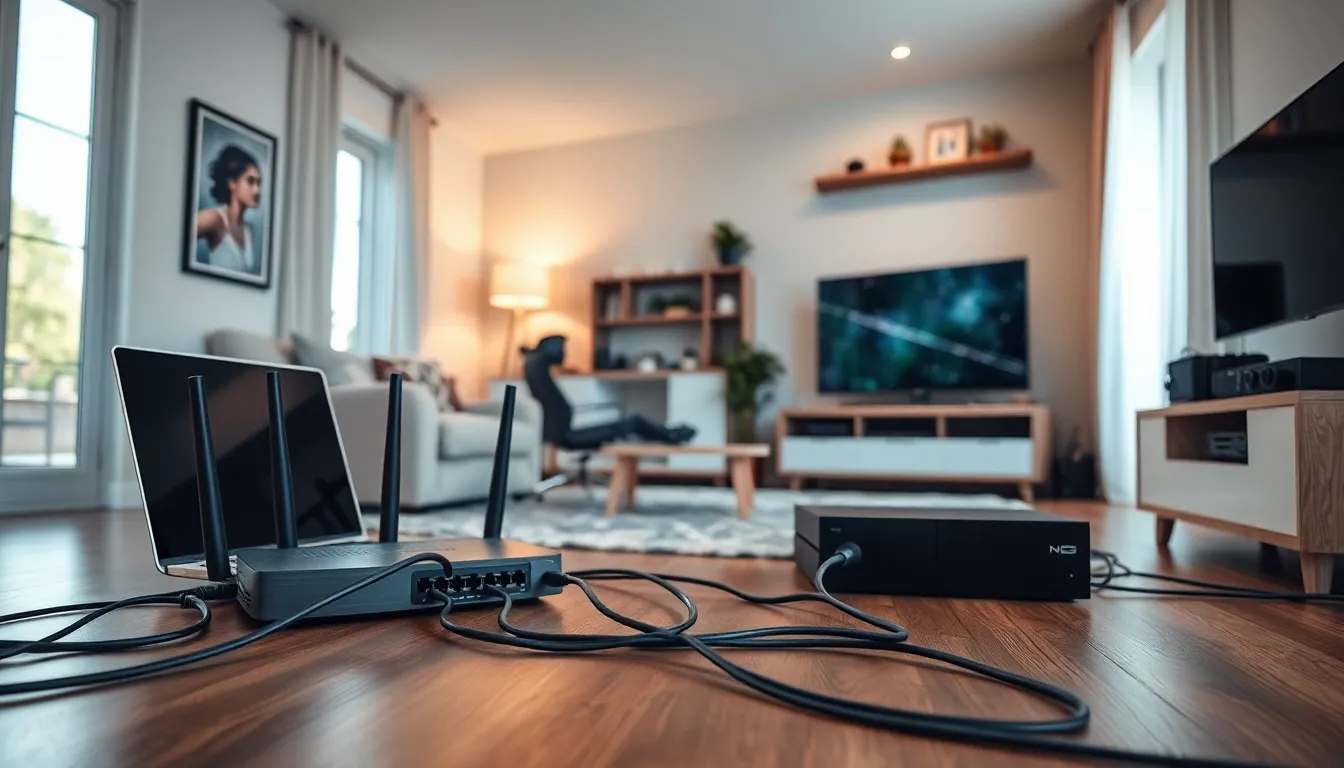In a world where Wi-Fi signals can be as fickle as a cat on a hot tin roof, a wired home network might just be your saving grace. Imagine streaming your favorite shows without the dreaded buffering symbol or gaming without lag—sounds like a dream, right? A well-designed wired home network diagram can turn that dream into reality, connecting every device with the reliability of a best friend who never flakes on plans.
But let’s face it, creating a home network can feel like assembling IKEA furniture without the instructions—confusing and potentially disastrous. Fear not! This guide will break down the essentials of a wired home network, making it easy to visualize and implement. So grab your tools and get ready to build a network that’ll have your devices singing in harmony, while you sit back and enjoy the uninterrupted internet bliss.
Table of Contents
ToggleOverview Of Home Networking
Home networking refers to the interconnection of devices within a home. Various networking components come together to create the infrastructure needed for reliable communication. A wired home network relies on Ethernet cables to connect devices directly to the router, enhancing stability and speeds compared to wireless options.
Devices such as computers, gaming consoles, smart TVs, and network printers typically benefit from a wired connection. Users experience reduced latency and fewer interruptions. Streaming 4K video or engaging in online gaming becomes more enjoyable, as wired connections handle high data demands efficiently.
Creating a wired network requires careful planning. He or she must consider the layout of their home and the placement of routers and switches. Diagramming the network helps visualize where cables need to run. Each room’s requirements must factor into the design for optimal performance.
Installation steps vary based on the home’s configuration. First, running Ethernet cables from the router to each device is essential. Then, organizing cables helps prevent clutter. Using wall plates offers a clean finish while maintaining accessibility.
Network switches expand connectivity by allowing multiple devices to connect to a single Ethernet port. They reduce reliance on wireless connections, lowering the risk of interference from other electronic devices. Choosing the right switch depends on the number of devices that will access the network.
Overall, setting up a wired home network improves internet reliability and performance. Users gain confidence in their ability to use high-bandwidth applications without concern for connectivity issues. Visualizing the layout aids efficiency, ensuring network design meets every user’s needs.
Components Of A Wired Home Network

Creating an effective wired home network relies on several essential components. Each element plays a crucial role in connecting devices and ensuring optimal performance.
Routers And Switches
Routers direct internet traffic and connect devices to the internet. They serve as the primary gateway for all home networking activities. Switches enhance the network by allowing multiple devices to connect through one router port. These devices facilitate communication between computers, gaming consoles, and smart TVs. When selecting routers and switches, prioritizing speed and capacity ensures a smoother online experience for all users.
Cables And Connectors
Ethernet cables form the backbone of a wired home network. They connect devices directly, ensuring fast and stable internet connections. Several types of Ethernet cables exist, including Cat5e, Cat6, and Cat6a. Each offers varying speeds and bandwidth capabilities. Connectors like RJ45 plugs secure the ends of Ethernet cables, providing reliable links between devices. Using quality cables and connectors minimizes latency and enhances overall network performance.
Network Devices
Network devices such as computers, printers, and streaming boxes benefit significantly from a wired connection. Each device links directly to the router or switch, reducing potential interruptions caused by wireless signals. Including a variety of devices caters to different usage requirements, such as gaming or streaming high-definition content. Ensuring compatibility between each network device and its corresponding router or switch maximizes efficiency and performance across the home network.
Designing A Wired Home Network Diagram
Creating a wired home network diagram involves careful planning and visualization. Understanding key factors will help ensure the design meets the home’s needs.
Key Factors To Consider
Consider the home’s layout, as it significantly influences network design. The placement of the router must allow optimal coverage for all devices. Ethernet cable lengths should range between 20 to 300 feet, depending on the distance to devices. Include switches where multiple devices connect, as each switch can accommodate up to 48 ports. Calculate total bandwidth desires, since high-demand tasks like video streaming require more capacity. Lastly, think about future expansions; the diagram should allow for easy additions of new devices and connections.
Step-By-Step Diagram Creation
Begin by sketching a basic floor plan of the home. Identify where the router will be placed for optimal signal distribution. Next, plot connections from the router to various devices—computers, gaming consoles, and smart TVs. Use straight lines to represent Ethernet cables for clarity. Label each device and indicate the type of connection, whether direct or through a switch. Ensure the diagram reflects the necessary cable lengths, and include all relevant components, such as connectors. A clear diagram simplifies installation and enhances overall network organization.
Benefits Of A Wired Home Network
A wired home network delivers superior reliability. Connectivity remains stable during heavy usage. Users experience fewer disruptions, making activities like streaming and gaming seamless.
Latency reduction is another significant benefit. Wired connections provide faster data transmission than wireless options. This speed is crucial for online gaming and high-definition content streaming.
Security strengthens with wired networks. Wired connections are inherently more secure compared to wireless signals, which are susceptible to interception. Users can safeguard sensitive information more effectively.
Additionally, wired networks support consistent performance. Multiple devices can connect simultaneously without performance degradation. This capability is essential in homes with high device usage.
Scalability also plays a vital role. Adding new devices becomes straightforward with a wired setup. Plugging in additional switches or hubs can expand the network as needed.
Moreover, installation offers flexibility in design. Creatively wiring a home allows users to tailor the setup according to specific needs. Effective planning ensures that Ethernet cables reach all areas where devices are located.
Cost efficiency presents an attractive advantage as well. While initial installation costs might be higher, the long-term benefits outweigh expenses. Reliability reduces the need for frequent upgrades or troubleshooting.
Energy efficiency often arises as a less-discussed, yet tangible benefit. Wired networks consume less power compared to high-powered routers and extenders used for wireless networks.
Emphasizing these advantages highlights the value of investing in a wired home network. Enhancing connectivity leads to improved user experiences across various online activities.
Common Mistakes To Avoid
Planning a wired home network requires attention to detail, and avoiding common mistakes enhances the setup. Ignoring the layout of the home can lead to inefficient cable runs and hinder device connectivity. Properly measuring distances for cable lengths prevents unexpected shortages or excess, which complicates installation.
Underestimating the number of devices is another frequent error. Assessing current and future needs allows for adequate bandwidth and connectivity options. Selecting subpar Ethernet cables can also impact performance; it’s vital to use high-quality cables such as Cat6 or Cat6a for optimal speeds.
Placement of the router plays a crucial role in network performance. Centralizing the router can provide better coverage and minimize cable lengths. Additionally, not using switches to expand connectivity results in missed opportunities for connecting multiple devices efficiently.
Neglecting to document the network setup can create confusion during troubleshooting. Keeping a record of the network diagram ensures easy reference for modifications or upgrades. Failing to organize cables effectively leads to clutter and poor airflow, which may affect equipment performance.
Lastly, overlooking security settings can expose the network to vulnerabilities. Implementing basic security measures, like changing default passwords, secures the network from unauthorized access. Prioritizing these aspects ensures a reliable and efficient wired home network.
Establishing a wired home network can transform the way devices connect and communicate. By prioritizing reliability and speed it provides an optimal environment for streaming gaming and other high-demand activities. Careful planning and thoughtful diagramming are essential to ensure a seamless setup that accommodates both current and future needs.
Investing time in understanding the components and layout will pay off with enhanced performance and reduced latency. A well-executed wired network not only boosts efficiency but also ensures a secure connection for all devices. With the right approach the benefits of a wired home network are clear making it a worthwhile endeavor for any household.








